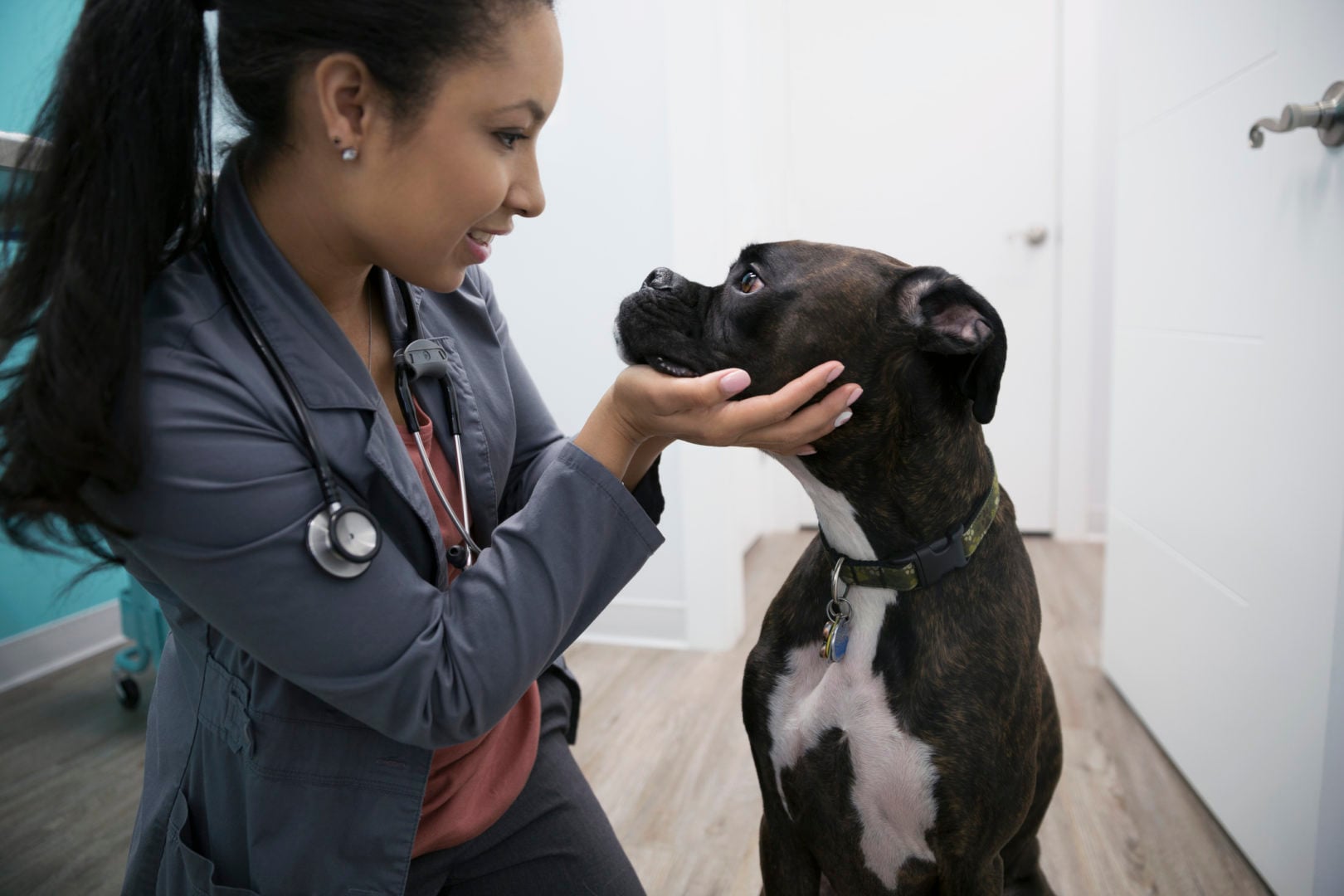Your dog is peeing more than usual, drinking copious amounts of water and seems to be sending you a signal that something just isn’t right. You may know these are symptoms of kidney disease, so it’s time for a vet visit is needed, stat.
“The sooner the signs of kidney failure in dogs are recognized, the earlier the diagnosis of kidney disease can be made and the easier we can slow down the progression of the disease,” says Dr. JD Foster, veterinarian and internist in the Internal Medicine department at Friendship Hospital for Animals in Washington, D.C.
Kidney disease is a condition that can look innocuous, can have the same signs as other diseases or sometimes have no recognizable symptoms at all, so it’s important to get a vet’s input about what is happening. To help you better understand the diagnosis, here’s a breakdown of signs, how it’s diagnosed and what you can expect by way of treatment.
What is kidney disease?
Sometimes called kidney (renal) failure, kidney disease occurs when a dog’s kidneys aren’t able to do their job, which is to remove toxins from the dog’s body. Dogs have two kidneys located within the abdomen along the spine, atop the bladder.
“The kidney is entirely responsible for maintaining the entire body’s homeostasis,” says Foster, “which includes water balance, balancing electrolytes and maintaining blood pressure.”
The kidneys aren’t just responsible for producing urine but also for regulating these systems.
“Urine is just a byproduct of all the other functions that the kidney does,” Foster explains. “So when we see problems with the kidneys, all of these areas can be affected, including digestion and metabolism.”
There are two types of kidney disease: acute and chronic.
Acute kidney injury
Acute kidney injury (AKI) is often sudden and progresses rapidly while chronic kidney disease takes much longer to manifest.
“Acute kidney failure can be due to injury or decreased blood flow to the body,” Foster says. “Or toxins can cause acute kidney injury. We really try to treat those underlying causes to give the best chance for recovery.”
Some of the causes of AKI include:
- Infections (like bacterial infection of the kidney).
- Toxins (like antifreeze; NSAIDs like aspirin; foods like grapes, raisins, currants).
- Some medications.
Chronic kidney disease
Chronic kidney disease (CKD) may be congenital, Foster notes, but most patients acquire kidney disease as they age.
“The cause of CKD is very challenging to determine,” he says, “as it likely initiated months to years prior to the time of diagnosis.”
What are the symptoms of kidney disease in dogs?
When it comes to kidney disease, there are certain symptoms that should spark concern right away.
“The most alarming symptoms include vomiting/anorexia, as well as a decrease in urine production,” Foster says. “While other things may also cause these symptoms, they should prompt an immediate visit to the veterinarian for evaluation. From the vet side, we may see oral ulcers, detect the presence of uremic toxins in the breath and may possibly feel abnormal kidney shape or size during our examination.”
Other signs of kidney disease in dogs
A sudden change in your dog’s well-being
“When your dog is suddenly acting very sick, this could mean acute kidney injury, but it might not be,” Foster says. “There can be many reasons why dogs suddenly seem very sick.”
A trip to the emergency vet is vital when sudden changes occur with your pet’s health.
Your dog is urinating more frequently
Frequent urination in dogs can be one of the first signs of acute or chronic kidney disease.
“If you find yourself having to take your dog out for a pee more frequently, keep track,” says Dr. Kimberly Hammer, a veterinarian and internal medicine specialist at NorthStar VETS in Robbinsville, New Jersey.
A decreased appetite
“If your dog suddenly does not want to eat, is anorexic and seems generally unwell, this could mean acute kidney failure,” says Foster. “If your dog seems to lose interest in his usual dog food and will only eat scraps and treats, this could signal kidney disease.”
Extreme lethargy
“If your dog just seems really tired, unwell and does not want to do anything, this might signal acute kidney injury, especially if accompanied by recent trauma to the kidney area,” says Foster.
And if you notice your happy, healthy dog getting more and more tired over time, this could indicate chronic kidney failure, he warns.
Excessive thirst
“If you find yourself needing to fill the water bowl up more frequently or find your dog looking for extra water sources,” says Hammer, “this could signal chronic kidney failure.”
Bad breath
Pets might “start to develop bad breath (that is quite noticeable) due to the toxins accumulated in their bodies,” says Hammer.
Changes to your dog’s bone structures
“They might develop a swelling on both sides of their face along the upper jaw, which is a complication of imbalances in their bodies,” says Foster. “This isn’t common but could raise a red flag.”
Diarrhea or constipation
Because the kidneys regulate the fluids in the body, you might see issues and changes concerning your dog’s bowel movements. If you observe any of these signs in your dog, be sure to contact your vet.
How is kidney disease diagnosed?
Kidney disease is diagnosed by a combination of bloodwork and urine testing, Foster says.
“Most clients can expect to have a CBC (complete blood count), biochemistry panel and full urinalysis performed,” he says. “Cost for these three tests are likely $200 to $400, depending on where you live. After kidney disease is suspected, further testing will likely be recommended.”
Foster says additional tests may include radiographs ($150 to $300), ultrasound ($300 to $600), urine culture ($100 to $200), blood pressure ($25 to $50) and other tests in some circumstances.
How is kidney disease treated?
Treatment for chronic kidney disease is multifaceted. It’s focused around nutrition, maintaining hydration, correction of anemia and normalization of electrolyte disturbances, according to Foster.
“Most dogs should be eating a prescription diet made for kidney disease; these foods have been shown to improve survival and reduce complications associated with kidney disease,” Foster says, adding that if a dog doesn’t like the taste of one type of diet, there are plenty of options available.
Keeping the dog hydrated is important and that can be managed, he says, by feeding a canned diet, adding extra water to the food, using esophageal feeding tubes or via subcutaneous fluids.
“Medications may need to be given to help keep their phosphorus and potassium concentrations normal,” Foster says. “If dogs become significantly anemic (due to a deficiency in erythropoetin, a hormone made by the kidneys), injections of erythropoetin will be initiated.”
In early stages, diet may be the only needed treatment. As the disease progresses, Foster says, your dog may require additional therapies.
Acute kidney injury is treated similarly, he notes, but many dogs are sick and require hospitalization for IV fluids and medications.
“Some may have severe enough disease where they require hemodialysis to help remove the toxins that have accumulated within the dog that is causing disease,” Foster says. “Dialysis can help a dog feel better, improving their quality of life as their kidneys heal. Dialysis can also be performed for dogs with advanced CKD, although their scenario is similar to people who receive dialysis — typically two to three times a week treatments are needed for the rest of the dog’s life.”
Dogs with AKI may only need dialysis over the course of one to four weeks; however, some patients may require a longer course of treatment.
What is the prognosis for a dog with kidney disease?
Obviously, your vet will be the one to determine what lies ahead should kidney disease be the diagnosis. In general, Foster says the prognosis for dogs with acute kidney injury is guarded, with an overall survival rate of 50% to 65%.
“Dogs with infectious disease (like leptospirosis) have a better survival than those who have had a toxin exposure,” he says.
Dogs with chronic kidney disease experience shorter survival rates as their disease progresses, he says, adding that veterinarians use the International Renal Interest Society (IRIS) staging system to characterize the severity of the dog’s condition, with the survival rate shortening as the stages advance.
“Stage I has an average survival of more than 400 days, Stage II 200 days, Stage III 100 days and Stage IV 14 to 100 days,” he says. “These survival statistics are old and retrospective. I generally see much better survival times for the patients I manage. The treatment for CKD is designed to slow the progression of disease; however, given enough time, dogs will advance in their disease severity and eventually we will be unable to provide them with a good quality of life.”





